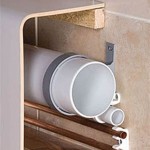Standard Hole Size For Bathroom Sink: A Comprehensive Guide
Understanding the standard hole size for a bathroom sink is crucial for successful plumbing installations and replacements. The dimensions of these holes directly impact the compatibility of faucets, drains, and other sink accessories. Deviations from the standard can lead to leaks, installation difficulties, and aesthetic inconsistencies. This article provides a comprehensive overview of the standard hole sizes, their respective functions, and the implications of these measurements.
Bathroom sinks are not uniform in design or configuration. They come in various styles, including pedestal sinks, undermount sinks, vessel sinks, and drop-in sinks. Each style may have different requirements concerning the number and placement of faucet and drain holes. While variations exist, adherence to industry standards ensures that most commercially available faucets and accessories are broadly compatible with a wide range of sink models. Knowing these standards is essential for both plumbing professionals and homeowners undertaking bathroom renovations.
Faucet Hole Standards
The most commonly encountered faucet hole configuration in bathroom sinks is the three-hole setup, designed for widespread faucets. However, single-hole and center-set configurations are also prevalent, each requiring specific hole sizes and spacing. Understanding these configurations is critical for selecting the appropriate faucet and ensuring a secure and watertight installation.
Three-Hole Faucets (Widespread): These faucets consist of separate hot and cold water handles, along with a central spout. The standard distance between the centers of the hot and cold water handle holes is 8 inches. This spacing allows for a more expansive and aesthetically pleasing design, particularly suitable for larger sinks. The diameter of each hole in a three-hole widespread configuration is typically 1 3/8 inches. This dimension provides sufficient space for the faucet shank to pass through and for the securing nuts to be tightened from underneath the sink.
Single-Hole Faucets: Single-hole faucets, as the name suggests, require only one hole in the sink. These faucets are characterized by a single lever or knob that controls both the water flow and temperature. The standard diameter for a single faucet hole is also typically 1 3/8 inches. This size accommodates the faucet shank and allows for secure mounting, typically using a mounting plate or gasket to ensure a watertight seal.
Center-Set Faucets: Center-set faucets are designed for sinks with three holes, but the spacing between the handles and the spout is much closer than with widespread faucets. They are generally configured with a 4-inch spacing between the centers of the handle holes. While the individual hole diameter remains consistent at 1 3/8 inches, the proximity of the holes requires careful consideration during installation to ensure adequate clearance for tools and secure tightening of the faucet hardware.
When selecting a new faucet, it is imperative to verify the existing hole configuration in the sink. If the sink has three holes, but a single-hole faucet is desired, a deck plate can be used to cover the unused holes and provide a stable mounting surface for the new faucet. Conversely, drilling additional holes in a sink is generally not recommended, especially for porcelain or ceramic sinks, as it can lead to cracking or chipping. The best practice is to choose a faucet that matches the existing hole configuration or to replace the sink if a different faucet style is preferred.
The material of the sink also plays a role in the installation process. Thicker sink materials, such as cast iron or certain types of stone, may require longer faucet shanks to ensure sufficient thread engagement for secure tightening. It is advisable to consult the faucet manufacturer's specifications to determine the appropriate shank length for the specific sink material.
Drain Hole Standards
The drain hole is a critical component of the bathroom sink, responsible for channeling wastewater away from the basin. The standard size of the drain hole ensures compatibility with most commercially available drain assemblies, including pop-up drains, grid drains, and basket strainers. A mismatch between the drain hole size and the drain assembly can lead to leaks and improper drainage.
The standard drain hole diameter for a bathroom sink is 1 3/4 inches (1.75 inches). This dimension is almost universally adopted across different sink styles and materials. The 1 3/4 inch drain hole is designed to accommodate a standard 1 1/4 inch tailpiece that connects the drain assembly to the P-trap. The tailpiece is typically threaded, allowing for a secure and watertight connection to the drain flange.
The drain flange, which sits flush with the bottom of the sink, is secured to the drain body from underneath. A rubber or silicone gasket is typically used between the drain flange and the sink surface to create a watertight seal. Over-tightening the drain assembly can damage the sink or the drain flange, while under-tightening can result in leaks. It is important to follow the manufacturer's instructions carefully when installing the drain assembly.
Variations in drain hole size are rare, but they can occur, particularly with older or non-standard sinks. Before purchasing a new drain assembly, it is prudent to measure the diameter of the existing drain hole to ensure compatibility. If the drain hole is significantly different from the standard 1 3/4 inches, it may be necessary to source a specialized drain assembly or replace the sink altogether.
The material of the drain assembly also warrants consideration. Brass drain assemblies are generally more durable and resistant to corrosion than plastic drain assemblies. Stainless steel drain assemblies offer a balance of durability and affordability. The choice of material depends on the specific application and budget.
Overflow Hole Considerations
Many bathroom sinks are equipped with an overflow hole, a small opening located near the top of the basin. The overflow hole is designed to prevent the sink from overflowing if the drain is blocked or if the faucet is left running unattended. The overflow hole is connected to a channel within the sink that leads to the drain, allowing excess water to escape.
While the overflow hole itself does not have a strictly defined standard size, its presence influences the selection of the drain assembly. Drain assemblies designed for sinks with overflow holes have corresponding openings that align with the overflow channel in the sink. These drain assemblies typically include a mechanism to prevent sewer gases from entering the bathroom through the overflow channel.
If a sink has an overflow hole, it is essential to use a drain assembly specifically designed for sinks with overflow. Using a drain assembly designed for sinks without overflow can lead to improper drainage and the potential for sewer gases to enter the bathroom. Similarly, if a sink does not have an overflow hole, using a drain assembly designed for sinks with overflow can create a potential leak path.
The size and shape of the overflow hole can vary slightly between different sink models. However, the corresponding opening in the drain assembly is typically designed to accommodate these variations. Some drain assemblies feature adjustable overflow connections to ensure a proper fit with a wide range of sink models.
Cleaning the overflow hole periodically is important to prevent the buildup of soap scum and debris, which can obstruct the flow of water and compromise the overflow's functionality. A small brush or pipe cleaner can be used to clear any obstructions in the overflow channel.
In summary, the standard hole sizes for bathroom sinks are critical for ensuring compatibility with faucets, drains, and other accessories. Adhering to these standards simplifies the installation process and reduces the risk of leaks and other plumbing problems. Understanding the different faucet and drain configurations, as well as the role of the overflow hole, is essential for both plumbing professionals and homeowners undertaking bathroom renovations.

Standard Bathroom Sink Dimensions With Photos Upgradedhome Com

What Is Standard Size Hole For A Kitchen Or Bathroom Faucet

Bwe 10 2 In X 3 1 34 Brass Kitchen Bathroom Sink Faucet Hole Cover Deck Plate Escutcheon Brushed Nickel P 10n The Home Depot

Standard Bathroom Sink Dimensions With Photos Upgradedhome Com

B613 Drop In 3 Faucet Holes Vanity Sink Bristol Sinks

What Is The Standard Size For Drain Hole In A Bathroom Sink Hunker

Kingston Brass Forum Lb24157 Ceramic Rectangular Undermount Bathroom Sink White

Homeowner S Guide To Bathroom Sink Dimensions And Sizes The Family Handyman

American Standard Decorum Vitreous China Wall Hung Rectangle Vessel Sink With Single Faucet Hole In White 9134001ec 020 The Home Depot

Standard Size For The Drain Hole In A Bathroom Sink Ehow
Related Posts







